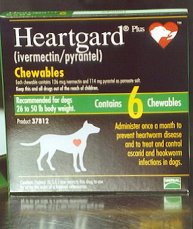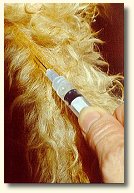|
Although its just another parasitic
organism, Dirofilaria immitis grabs our attention more than any
other parasite, especially those of us who have pets. We see signs in
pet stores and watcher commercials on T.V. that tell us the dangers of
dog heartworm and what we should do to prevent it. Through this website
my goal is not only to present an in depth analysis of Dirofilaria
immitis, but also to give those of you who own dogs or other pets
information on how to prevent or treat your four legged family member.
Listed below are things that you should know about prevention or
treatment of Dirofilaria immitis and some interesting facts about
the parasitic organism.

Prevention
(According to the American Heartworm Society)
- Giving your pet chewables or
tablets on a monthly basis
- Applying topical medication to
your pets back
- Knowing the right time to give
your pet these preventative medications ( A good rule of thumb is if
there are mosquitoes present in the environment, your pet needs to
be protected)

Clinical Signs
(According to the American Heartworm Society)
|
Clinical
Signs Associated with Canine Heartworm Disease |
|
Early Infection |
No abnormal
clinical signs observed |
|
Mild Disease |
Cough |
|
Moderate Disease |
Cough, exercise
intolerance, abnormal lung sounds |
|
Severe Disease |
Cough, exercise
intolerance, dyspnea (difficulty breathing), abnormal lung
sounds, hepatomegaly (enlargement of the liver), syncope
(temporary loss of consciousness due to poor blood flow to the
brain), ascites (fluid accumulation in the abdominal cavity),
abnormal heart sounds, death |
Table above taken from the American
Heartworm Society.
Diagnosis
(According to Casiraghi 2006)
Here are a few ways in which
Dirofilaria immitis is diagnosed:
- Morphological observation of
circulating microfilariae (mf)
- Detection of circulating
antigens
- Histochemical or
immuno-histochemical staining of circulating (mf)
- Molecular approaches

Treatment
(According to the American Heartworm Society)
The good news is that most of the
time treatment of dog heartworm is successful. The goal of the
treatment is to kill the adult worms and all microfilariae. The only
drug on the market approved by the FDA to safely eliminate
Dirofilaria immitis is Melarsomine dihydrochloride. Other
treatments are being worked on and tested.

DON’T SQUIRM WHEN
YOU HEAR ABOUT THE WORM, JUST GET YOUR PET TESTED!!!!
Here are some interesting facts from
the American Heartworm Society:
- Old
female heartworms can measure up to 31 cm in length
-
Evidence suggests that adult heartworms have a relatively short
lifespan in a cat compared to a dog
- The
normal habitat of the adult heartworm is the right ventricle and
adjacent blood supply of the dog
-
Heartworms have also been found in the liver, trachea, esophagus,
stomach, feces, eye, brain, spinal cord, and vomit in dogs
-
Heartworms have been known to occur in the cat for more than half a
century
- The
first published description of heartworm in a dog appeared in the
October 1847 issue of “The Western Journal of Medicine and Surgery”
-
Heartworms are considered Ovoviviparous

|





